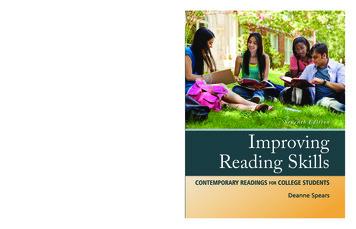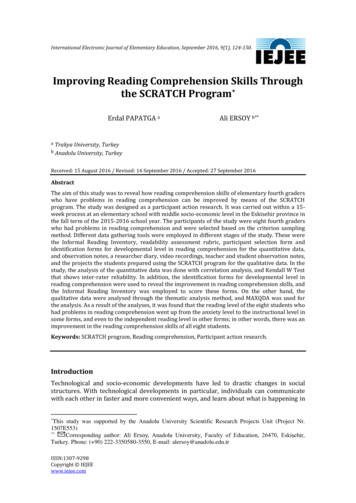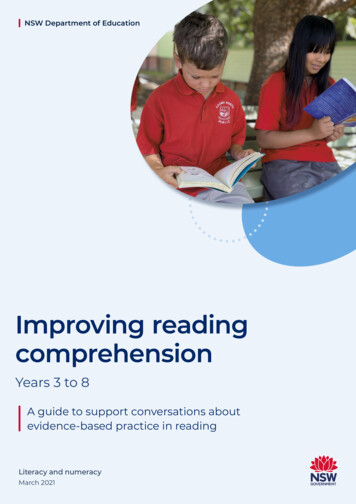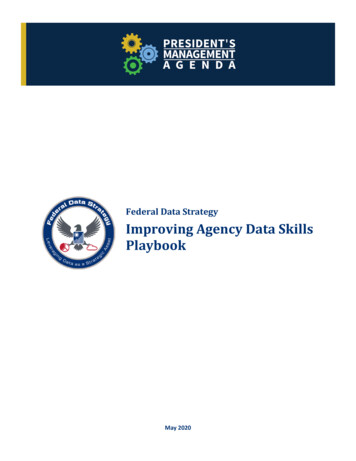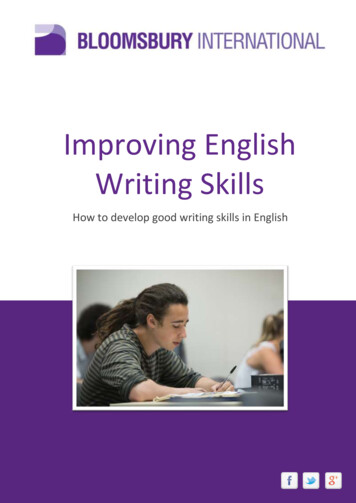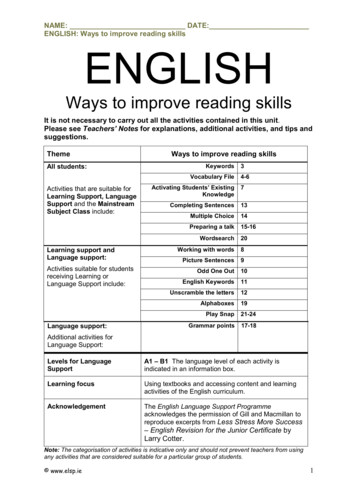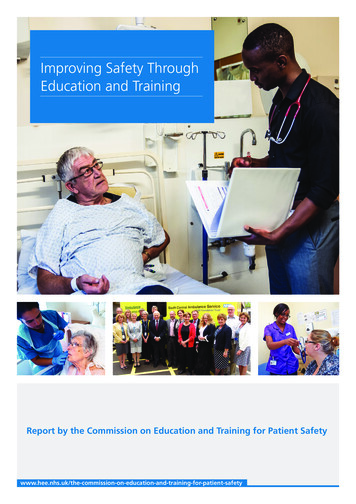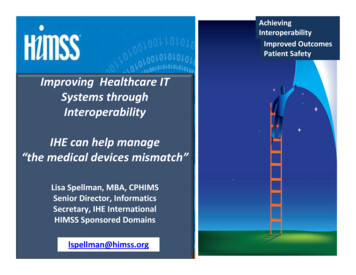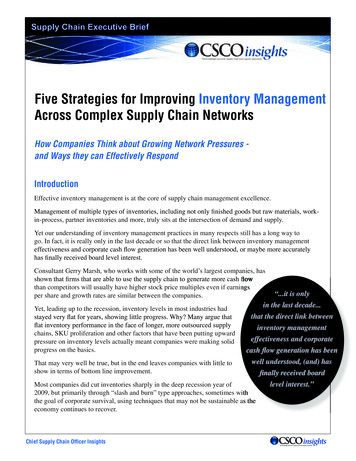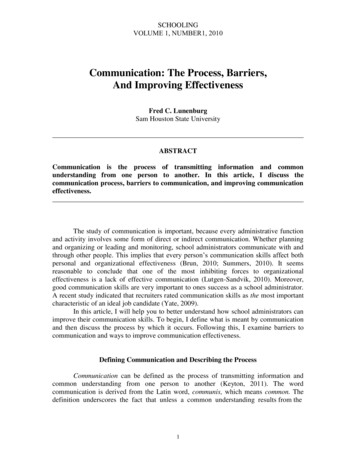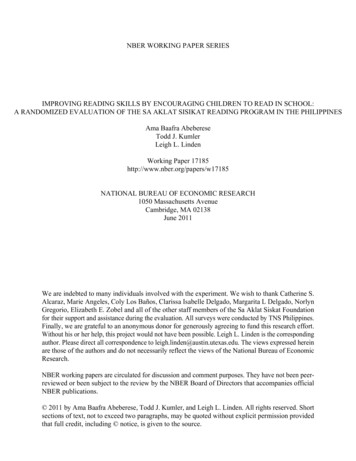
Transcription
NBER WORKING PAPER SERIESIMPROVING READING SKILLS BY ENCOURAGING CHILDREN TO READ IN SCHOOL:A RANDOMIZED EVALUATION OF THE SA AKLAT SISIKAT READING PROGRAM IN THE PHILIPPINESAma Baafra AbebereseTodd J. KumlerLeigh L. LindenWorking Paper 17185http://www.nber.org/papers/w17185NATIONAL BUREAU OF ECONOMIC RESEARCH1050 Massachusetts AvenueCambridge, MA 02138June 2011We are indebted to many individuals involved with the experiment. We wish to thank Catherine S.Alcaraz, Marie Angeles, Coly Los Baños, Clarissa Isabelle Delgado, Margarita L Delgado, NorlynGregorio, Elizabeth E. Zobel and all of the other staff members of the Sa Aklat Siskat Foundationfor their support and assistance during the evaluation. All surveys were conducted by TNS Philippines.Finally, we are grateful to an anonymous donor for generously agreeing to fund this research effort.Without his or her help, this project would not have been possible. Leigh L. Linden is the correspondingauthor. Please direct all correspondence to leigh.linden@austin.utexas.edu. The views expressed hereinare those of the authors and do not necessarily reflect the views of the National Bureau of EconomicResearch.NBER working papers are circulated for discussion and comment purposes. They have not been peerreviewed or been subject to the review by the NBER Board of Directors that accompanies officialNBER publications. 2011 by Ama Baafra Abeberese, Todd J. Kumler, and Leigh L. Linden. All rights reserved. Shortsections of text, not to exceed two paragraphs, may be quoted without explicit permission providedthat full credit, including notice, is given to the source.
Improving Reading Skills by Encouraging Children to Read in School: A Randomized Evaluationof the Sa Aklat Sisikat Reading Program in the PhilippinesAma Baafra Abeberese, Todd J. Kumler, and Leigh L. LindenNBER Working Paper No. 17185June 2011, Revised July 2013JEL No. I21,I28,O15ABSTRACTWe show that a short-term (31 day) reading program, designed to provide age-appropriate readingmaterial, to train teachers in their use, and to support teachers’ initial efforts for about a month improvesstudents’ reading skills by 0.13 standard deviations. The effect is still present three months after theprogram but diminishes to 0.06 standard deviations, probably due to a reduced emphasis on readingafter the program. We find that the program also encourages students to read more on their own athome. We find no evidence that improved reading ability improves test scores on other subjects.Ama Baafra AbebereseDepartment of EconomicsColumbia University420 West 118th Street, MC3308New York, NY 10027aba2114@columbia.eduTodd J. KumlerDepartment of EconomicsColumbia University420 West 118th Street, MC3308New York, NY 10027tjk2110@columbia.eduLeigh L. LindenDepartment of EconomicsThe University of Texas at Austin2225 SpeedwayBRB 1.116, C3100Austin, Texas 78712and NBERleigh.linden@austin.utexas.edu
I. IntroductionSeven hundred and seventy-five million adults cannot read (UIS, 2011). The poor quality ofpublic schools in developing countries is a major factor. However, our limited understanding ofthe education production function hinders attempts to ameliorate their conditions. We knowproviding resources without other inputs rarely improves student performance. We knowresources can affect improvements when paired with a larger array of inputs (Glewwe andKremer, 2006). We do not know which inputs are necessary. For reading in particular, studieshave demonstrated the effectiveness of large comprehensive changes. Banerjee et al. (2007),which studies an Indian remedial education program, is a good example. The intervention causesstudents’ reading skills to improve, but because the intervention changes the educationalenvironment along multiple dimensions—additional teachers, new pedagogical methods, newcurriculum, changes to organization of the classroom, and additional resources—we cannotidentify which components cause the improvements.We approach this challenge by assessing the causal effects of a reading program thatchanges children’s educational experience along a single dimension common to morecomprehensive reading programs: getting children to actively read age-appropriate books atschool. Schools rarely encourage children to read. Curricula do not emphasize it, and mostschools even lack age-appropriate reading material. Comprehensive reading programs encouragechildren to read during the school day by providing age-appropriate reading material, segregatingtime for reading, group reading, reading-based classroom games and other pedagogical changesdesigned to get teachers to read books with students.2 To better understand the mechanisms2As part of larger programs, this might be combined with professional development for teachers, the creation ofnew infrastructure such as school libraries, student reading assessment techniques, changes in personnel (such as theaddition of a reading instruction coordinator or additional instructors), and often the use of new technologies thatprovide more functionality than traditional books (eReaders, tablets, or even computer assisted instruction).-1-
through which the larger programs operate, we assess a program that only provides teachers withnew materials and trains teachers to use them.Using a randomized controlled trial set in Tarlac province of the Philippines, we analyzethe causal impact of the Sa Aklat Sisikat (SAS) reading program for fourth graders. The programprovides age-appropriate reading material, trains teachers to incorporate reading into theircurriculum, and supports these changes through a 31-day reading marathon, during which SASsupports teachers as they encourage students to read. We randomly assigned, by school, 5,510fourth-grade students in 100 schools to receive the intervention following a baseline assessmentof students’ reading skills at the start of the academic year. We then administered two follow-upsurveys: after all of the marathons were complete (four months after baseline) and at the end ofthe academic year (seven months after baseline).Simply enabling and encouraging students to read age-appropriate books in schoolquickly creates meaningful improvements in reading skills. On average, reading scores increasedby 0.13 standard deviations by the end of the marathons. However, while the effects did persist,scores declined by 54 percent over the next three months. This suggests that providing resourcesand training alone is a viable short-term strategy for meaningfully improving children’s readingskills, but by themselves they are insufficient to sustain those improvements.The fade-out may have been due to teachers deemphasizing reading. During themarathons, the implementing NGO ensured that teachers provided time for reading, but while theteachers retained all of the materials after the program ended, they also regained control over theamount of time dedicated to the subject. Consistent with this hypothesis, we find the programincreased the number of books children read in school in the last month by 7.17 during themarathon period, but by 56 percent less at the second follow-up. In fact, if we use the number of-2-
books read in the last month as a proxy for teachers’ emphasis on in-school reading, the localaverage treatment effect (LATE) estimates of the change in standard deviations per book read isthe same in both periods. This suggests that time spent on reading in school was equally effectivein both periods, but test scores declined because the time declined after the first survey. Tosustain long-term gains, interventions like the read-a-thon may need to be paired with othercomponents designed to support a long-term focus on reading, such as administrative andprofessional development interventions.Finally, researchers often prioritized reading, hoping that better reading skills will equipchildren to learn other subjects and encourage them to read outside of school. We assess the firsthypothesis by testing children in math and social studies, but we find no effect for either subject.However, we do find that in-school reading encourages children to read outside of school. Forexample, treatment children read 1.24 and 0.89 more books in the last month at the first andsecond follow-up surveys.The remainder of the paper is organized as follows. Section II provides an overview ofthe intervention. We describe the research design in Section III. Section IV documents theinternal validity of the study, and in Section V, we estimate the effects of the treatment. Wecompare the results to those of other studies of reading programs in Section VI. Finally, weconclude in Section VII.II. The Sa Aklat Sisikat Read-A-ThonThe reading program evaluated in this study is a core program of Sa Aklat Sisikat,3 a non-profitorganization located in Manila dedicated to building a nation of readers. Since its inception in1999, SAS has implemented its reading program in every province in the Philippines, reaching3Sa Aklat Sisikat loosely translates as “books make you cool.”-3-
over 750 public schools and nearly 150,000 students. The program comprises threecomponents—providing schools with a set of age-appropriate books, training teachers toincorporate reading in the curriculum, and through a 31 day “read-a-thon”, encouraging childrento read and supporting teachers as they incorporate reading into their classes. The programtargets fourth grade students because the school system expects students to have developedsufficient reading fluency to enjoy independent reading by the fourth grade.4Because most public schools lack age-appropriate reading material,5 SAS donates 60Filipino storybooks to each classroom. The books are selected for literary value as well asstudent appeal. They also include in both of the country’s official languages, English andFilipino, so that teachers can match the language of instruction.6Prior to receiving the materials, teachers from each school attend a two-day trainingsession in which they learn to implement the read-a-thon and receive ideas for reading lessonsthat incorporate reading in an engaging way. For 31 days after the training, they implement theread-a-thon. During this period, the students and teachers use the donated storybooks in hourlong daily reading sessions that include activities such as dramatic storytelling, literary games,and individual silent reading. Students are encouraged to read as many of the 60 storybooks aspossible, and each keeps track of the number of books read using an SAS supplied wall chart.4Reading fluency is the degree to which beginning readers rely less on the phonemic decoding to recognizeindividual words and instead recognize whole words. This change significantly increases reading speed andcomprehension. Meyer and Felton (1999), for example, define fluency as “the ability to read connected text rapidly,smoothly, effortlessly, and automatically with little conscious attention to the mechanics of reading, such asdecoding.”5For example, during our visits to local schools, we observed a few schools with libraries. However, most of thebooks were donated from developed countries. The subjects and writing styles were not age appropriate. It was not asurprise that teachers used them infrequently.6The Philippines has two official languages, Filipino and English, and under an existing executive order, schools areallowed to instruct students in either language. In our sample, students were instructed in Filipino. For this reason,we conducted all evaluations in Filipino as well.-4-
Students also write their thoughts about the stories in reading notebooks. Finally, SAS alsomonitors schools to ensure program fidelity and to support teachers’ use of the new books.While the read-a-thon itself only lasts 31 days, the schools keep the 60 books. SAS leavesthem for the teachers to use at their discretion. Although, they expect the intense read-a-thonexperience will encourage teachers to continue using the books and students to continue reading.III. MethodologyA. Research DesignThe research sample consists of all fourth-grade classrooms at 100 elementary schools in Tarlacprovince. Prior to the experiment, Sa Aklat Sisikat had never conducted its reading programthere.7 SAS and the province superintendent selected nine geographically proximate districts,representing a range of academic performance levels. From the nine districts, 100 schools werechosen for the experiment; this included all school from most of the districts.A baseline survey was conducted in all 100 schools in July 2009. Following the survey,schools were assigned to the treatment and control groups using a matched-pair stratifiedrandomization. Schools were divided into pairs within each district using the school levelaverage baseline reading scores.8 Within each pair, one school was assigned to the treatmentgroup and the other to the control group with equal probability. The read-a-thon was thenimplemented between the months of September and November.9 Two follow-up surveys wereconducted. The first was conducted immediately after the implementation of the read-a-thon in7In addition, relatively few other reading interventions had been conducted in the province.We have also estimated the primary specifications including fixed effects for the original groupings for therandomization. The results are consistent with those presented below. These results are available upon request.9During the implementation of the read-a-thon, Tarlac experienced severe flooding that led to the cancellation ofseveral days of school in many of the school districts. In addition, all-school events such as science fairs, townholidays, and standardized testing caused schools to take days off from the read-a-thon. However, all treatmentschools completed the 31 day read-a-thon prior to the first follow-up examination.8-5-
late November 2009 to measure the immediate effects of the intervention. The second wasconducted at the end of the academic year in late February 2010 to determine whether the effectspersisted after SAS ceased interacting with the treatment schools.B. DataEach survey round contained a reading skills assessment. These exams were based in part on anational reading examination created and administered annually by the Philippine Department ofEducation.10 The examination comprised sections covering six competencies. In the first part ofthe test (referred to as the “Written Test”), students are asked to silently read a written passageand answer written multiple-choice questions relating to the passage. Next, students were givenone-on-one oral reading tests covering letter recognition, sound recognition, and wordrecognition. Finally, students were asked to read a passage aloud (referred to as the “OralReading” Test) and then to answer several questions about the passage orally (“Oral ReadingQuestions”). For each section, we normalized students’ scores relative to the control distribution.Because the values for each section are not measured using the same units, we created acomposite reading score by averaging the normalized scores from each section and normalizingthe average, again relative to the distribution in the control group.A local survey firm proctored and graded all of the examinations independently of theteachers to guarantee their validity. In addition, teachers were not informed in advance of thecontent of the exam to prevent them from preparing students for the test. In order to ensure that a10We chose to use sections of the national exam in order to ensure that both treatment and control groups wereassessed using an instrument with which both groups were equally familiar. We wanted to avoid, for example,choosing an exam that might be geared towards the intervention being tested, which would have favored thetreatment students. The letter, sound, and word recognition sections were added to assess more basic competenciesthan typically tested on the official exam.-6-
large percentage of students were tested, the survey team returned to many schools multipletimes.Each survey also contained data unique to the individual round. In the baseline survey,we collected children’s age, gender, height, weight, number of siblings, religion, and the dialectspoken at home. In the follow-up surveys, we collected information on children’s reading habitsas well as tested students in other subjects to investigate possible spillovers from theintervention. The reading survey asked students about the number of books they read in the lastweek and the last month both in and out of school. We also asked students to name the title andto describe the plot of the last book they read to assess the validity of their responses. For thealternate subjects, we tested a different subject each round. In the first follow-up survey, wetested children’s math skills, and in the second one, we tested children’s knowledge of socialstudies, the most reading intensive alternate subject.C. Statistical ModelsWe utilize three basic models. First, we employ a simple difference specification to directlycompare the treatment and control groups:Yis α β1Ts εis(1)where Yis is the outcome of interest for child i in school s; and Ts is an indicator variable forwhether the school received the reading program. Hence, the estimate of the coefficient β1indicates the differences between treatment and control schools. We utilize this model tocompare baseline differences in socio-demographic characteristics and test scores and to estimatethe effect of the reading program on follow-up test scores and reading habits.-7-
Since the reading program was randomly assigned to schools and therefore independentof baseline characteristics, inclusion of observable baseline characteristics and baseline testscores as control variables in equation (1) improves the precision of the estimated treatmenteffect. We also run the following specification:Yis α β1Ts β2Xis ωd εis(2)where Yis and Ts are defined as in equation (1), and where Xis is a vector of baseline studentcharacteristics including composite baseline reading test score, gender, age, religion dummies,dialect dummies, and body mass index (BMI). Since the randomization was stratified withindistrict, we also include district fixed effects, ωd, in equation (2).Finally, we test the validity of the experiment by comparing the effect of the treatment onthe relative characteristics of the children who attrited from the sample between the baselinesurvey and the two follow-up surveys. We run the following difference in differences model:Yis α β1Ts β2Attritis β3Ts*Attritis εis(3)The variables Yis and Ts are defined as before, and Attritis is an indicator variable equal to one ifstudent i enrolled in school s was not present in the follow-up data. The estimate of β2 thenprovides the average differences between attritors and non-attritors in the control group, and theestimate of β3 captures the difference-in-differences between attritors and non-attritors in thetreatment and control groups.Because outcomes may have been correlated within school, failure to correct the standarderrors could result in an overestimate of the precision of the treatment effects (Bertrand, Duflo,Mullainathan, 2004). We therefore cluster the standard errors at the school level (the level ofrandomization) in all of the above models.-8-
IV. Internal ValidityRandomly assigning schools to the intervention ensured that assignment was orthogonal tostudent characteristics correlated with the outcomes of interest. If this holds, then any differencesin outcomes between the two groups post-intervention can be causally attributed to theintervention. To check that student characteristics in each group were indeed similar, we runregressions of student characteristics from the baseline survey on treatment assignment, and thenwe verify that any changes in the sample due to attrition are also uncorrelated with treatmentassignment.We present the comparison of students at baseline in Table 1. Column 1 contains theaverage characteristics for the control group. Columns 2 and 3 present the estimated differencesbetween the treatment and control groups. The results in column 2 do not include any controls,while those in column 3 control for district fixed effects. Panels A and B contain standardizedreading test scores and demographic characteristics, respectively.The differences in average characteristics between the control and treatment groups areall practically small and mostly statistically insignificant. In Panel A, none of the differences intest scores are statistically significant. Figure 1 shows a plot of the distribution of thestandardized overall reading test score for the treatment group (solid line) and the control group(dashed line). These distributions almost overlap completely, further corroborating thecomparability of the research groups. In Panel B, the only demographic variables withstatistically significant differences are those related to religion, but these differences are small inmagnitude. For instance, 74 percent of students in the control group were Catholics compared to69 percent in the treatment group, yielding a minimal difference of 5 percentage points. Therandomization thus appears to have successfully created similar treatment and control groups.-9-
Although the baseline comparisons presented in Table 1 and Figure 1 show that thetreatment and control groups were similar at baseline, it is possible that non-random attritionfrom the two groups between the baseline and follow-up surveys may have rendered the twogroups incomparable. Table 2 shows the attrition rates for both groups and the differencesbetween the two. There are no statistically significant differences between the attrition rates forthe control and treatment groups. For both groups, approximately 5 percent of the students whowere tested during the baseline survey were absent during the first follow-up survey, and 11percent were absent during the second survey. Comparing the rates across research groups, therates were the same in the first follow-up and differ by only 2 percentage points in the second (10percentage points in the treatment schools and 12 in the control).Columns 4 through 6 provide estimates of the attrition rates between follow-up surveys.Overall, 86 percent of the students were present at both follow-up surveys (column 4), and thedifference in the rates between research groups is small. Similarly, 91 percent of students whowere present at the first follow-up were also present at the second, and of those present at thesecond, 97 percent were present at the first.Even though the attrition rates were similar for both groups, the characteristics of theattritors and non-attritors could have still differed. We check this in Table 3 for the first followup survey. The results for the second follow-up survey are similar and presented in the Appendix(Table A1). Panel A focuses on test scores while Panel B focuses on demographiccharacteristics. Columns 1 and 2 contain the average characteristic for non-attritors in the controland treatment groups, respectively, while column 3 contains the difference between theseaverages estimated using equation (1). All of the differences are statistically insignificant withthe exception of the proportion of non-attritors who were Catholic. However, this difference is- 10 -
small in magnitude (5 percentage points) and is identical to the difference found for the entiresample during the baseline survey.The last three columns of Table 3 show that the differences between the characteristics ofthe non-attritors and attritors are similar across the two groups, indicating that there was noselection in the sample due to attrition. Column 4 presents the difference in averagecharacteristic between the non-attritors and the attritors in the control group. Column 5 presentsthe same statistic for the treatment group, and column 6 presents the difference between the twostatistics using equation (3). These differences are mostly statistically insignificant, and all ofthem are small in magnitude. We therefore conclude that the comparability of the control andtreatment groups was sustained throughout the follow-up surveys.V. ResultsA. Effect on Reading HabitsThe primary goal of the SAS reading program is to provide children the opportunity and meansto read in-school and to encourage them to do so. As a result, we start by assessing whether ornot students in schools assigned to the program did, in fact, read more in school. Table 4compares reading rates across the two groups based on survey responses during the first andsecond follow-up surveys. Variables include students’ responses to questions on whether or notthey had read a book and the number of books read in the last week and month. To check thatstudents who claim to have read a book actually did, we recorded whether children could nameand summarize the last book they read.The first three columns report results from the first follow-up survey, while the last threecolumns report results from the second follow-up survey. For each survey, the first column- 11 -
provides the average responses for the control group. The second and third columns provideestimates of the differences between groups without controls (equation (1)) and with controls(equation (2)).During the period in which the read-a-thon was implemented, the program didsignificantly increase the amount students read in school. The results in columns 1 and 3 showthat 68 percent of the students in the control group reported reading a book in school in the pastweek on the first follow-up survey, and the program increased this by 19 percentage points. Thestudents in the control group reported reading an average of 1.9 books in school in the past weekand the program increased this by 2.3 books. In the past month, the program increased thenumber of books read by 7.2 books.Further corroborating these results,11 we find significant differences in the propensity toread if we only consider a child as having read a book if he or she can provide specificinformation about the last book read. If we consider children to have read a book only if theyclaim to have read a book and could provide the title, 53 percent of students in the control groupread a book in the last week and the increase due to the program was 30 percentage points. If thecondition is to describe the plot, the program caused 23 percentage points more children to haveread a book. All of these results are statistically significant at the 1 percent level and are basicallythe same for the different specifications presented in columns 2 and 3.After the program, the effects on student reading seem to have continued, but at abouthalf of the previous rate. In terms of the probability that a student read a book (row one) or could11One of the concerns with these self-reported numbers is that, knowing that they are generally expected to read,students might have lied to surveyors about having read a book recently. The additional questions about the booksprovide one check. Also interesting in this respect, is the stability of the estimates for the fraction of children havingreported reading a book (and being able to provide the title and description) across the various surveys. For thecontrol students, for example, the largest difference in rates is for the fraction of students reporting reading a bookand being able to describe the book in Panel A at 9 percentage points. The next largest difference is 6 percentagepoints (being able to give the title and reporting having read a book in Panel A). The other five differences betweenthe surveys are all in the range of 2-3 percentage points.- 12 -
identify the title (row four) or plot (row five), the effects of the program seem to be the same asduring the read-a-thon period. However, when the questions focus on the number of books ratherthan just whether or not a child read any book, the magnitudes decline. The effect on the numberof books read in the last week is a statistically insignificant 0.86 and the effect on the number ofbooks read in the last month is 3.12, statistically significant at the 1 percent level. This suggeststhat the program did have a long-term effect, but that the amount of time children spend readingdeclined after the direct support of the program was removed.B. Effect on Reading AbilityWe now explore the extent to which the changes in reading affected students’ reading ability.Table 5 presents estimates of the differences between the standardized average reading testscores of the control and treatment groups. We present three estimates: an estimate of thetreatment effect without any controls (column one, equation (1)), an estimate including onlydemographic characteristics (column two), and an estimate controlling for demographiccharacteristics and district fixed effects (column three, equation (2)).Starting with the results from the first follow-up survey, the program had a distinctimmediate effect on students’ reading skills of 0.13 standard deviations. The results areconsistent across the various specifications, highlighting the comparability of the treatment andcontrol groups. And, in our preferred specification (column three), the results are statisticallysignificant at the 1 percent level. Consistent with the reduction in the amount of reading childrendo at school, we find that the treatment effect declines between the first and second follow-upsurveys to 0.06. The estimate is still consistent across the specifications and statisticallysignificant at the 5 percent level, but it is 54 percent smaller.- 13 -
To further investigate this relationship, we use the number of books a child reportsreading in the last month in school as a proxy for the time teachers spend on reading. We thenestimate local average treatment effects of reading on students' reading test sc
Improving Reading Skills by Encouraging Children to Read in School: A Randomized Evaluation of the Sa Aklat Sisikat Reading Program in the Philippines Ama Baafra Abeberese, Todd J. Kumler, and Leigh L. Linden NBER Working Paper No. 17185
